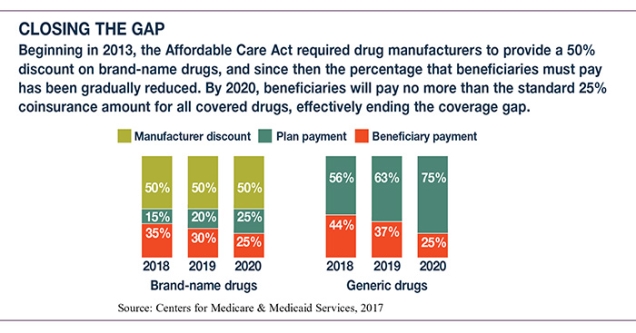Down the Donut Hole: The Medicare Coverage Gap

One of the most confusing Medicare provisions is the prescription drug coverage gap, often called the "donut hole." It may be clearer if you consider the gap within the annual "lifecycle" of Medicare Part D Prescription Drug Coverage. This also applies to drug coverage that is integrated into a Part C Medicare Advantage Plan.
Annual deductible. Prescription drug plans typically have an annual deductible not exceeding $405 in 2018. Before reaching the deductible, you will pay the full cost of your prescriptions, although you may receive negotiated discounts.
Initial coverage period. After you meet the annual deductible, your plan will pay a portion of your prescription drug costs, and you will typically have a copayment or coinsurance amount. A 25% coinsurance amount is the standard coverage required by Medicare, but most plans have different levels or "tiers" of copayments or coinsurance for different types of drugs.
Coverage gap. When you and your plan combined have spent a specified amount on drugs for the year ($3,750 in 2018), you enter
the coverage gap. In 2018, you pay 35% of your plan's price for covered brand-name prescription drugs and 44% of the price for generic drugs. The gap is closing over the next two years (see chart).
You remain in the coverage gap until you reach an annual out-of-pocket spending limit ($5,000 in 2018). Spending that counts toward the limit includes your deductible, copay, and coinsurance; the manufacturer's discount on brand-name drugs in the coverage gap; and your out-of-pocket payments in the gap. It does not include your premiums, the amount the plan pays, or your payments for noncovered drugs.
Catastrophic coverage. Once you have reached the out-of-pocket limit, you receive catastrophic coverage with much lower payments. In 2018, you would pay the greater of 5% of drug costs or $3.35/$8.35 for each generic and brand-name drug, respectively.
Some plans have more generous coverage in the gap. You may be able to avoid the coverage gap by using generic medicine, when appropriate, to lower your drug costs.
For more information, see Medicare.gov.


